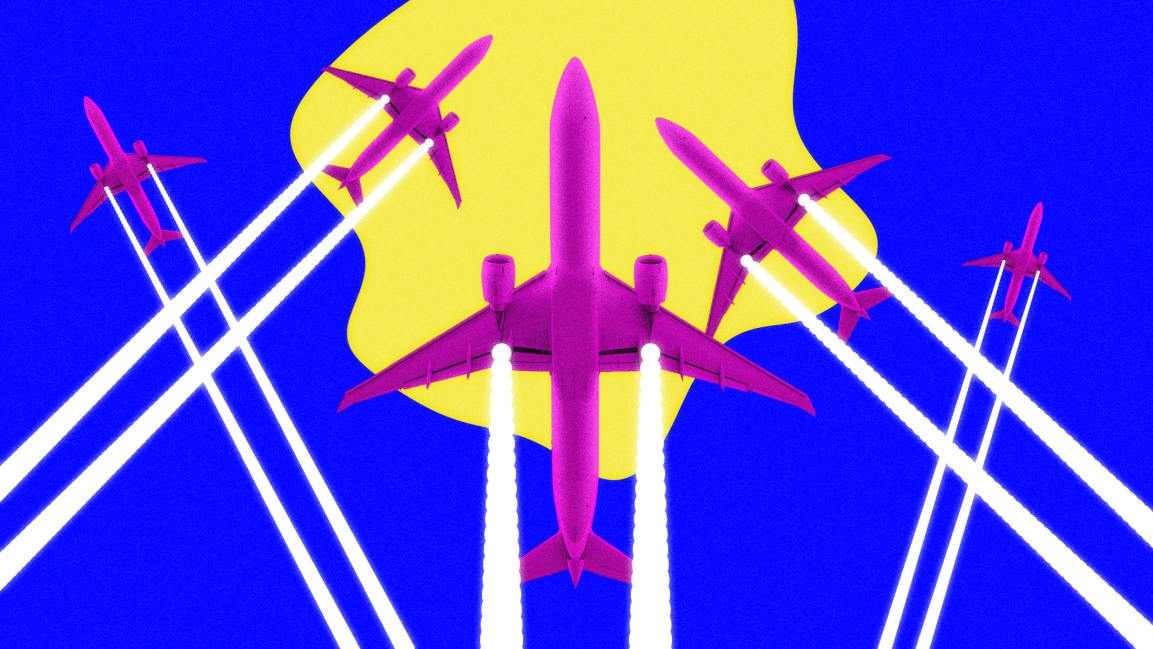A simple way to make flying less bad for the environment: just fly the planes at different altitudes
Air travel has a big environmental footprint, and not only because of the fuel necessary to power a plane thousands of miles. Those wispy clouds an airplane leaves in its wake, called contrails, play a significant role in global warming, and researchers have said that as flights get more fuel efficient and air traffic gets worse, we’ll see more, longer-lasting contrails, with harsher effects. But new research from Imperial College London suggests there may be an easy solution: diverting a few flights to slightly higher or lower altitudes, which could cut the climate impact of contrails by more than half.
Contrails form when a plane’s warm engine exhaust meets the cold, low-pressure air around the plane in the atmosphere. Water vapor freezes around black carbon particles in the exhaust, and we see the condensation as streaks of clouds through the sky. Though contrails don’t last all that long—dissipating in either a few minutes or hours, depending on the humidity—they have dire environmental consequences.
Contrails cause an effect known as “radiative forcing,” where they trap heat radiating from the Earth’s surface, preventing it from releasing into the atmosphere, thus warming the air below. Research has suggested that contrails have a daily impact on atmospheric temperature greater than all the accumulated carbon emissions from all aircrafts, since air travel first began.
“They are short lived, but they have a strong effect during the time that they exist,” says Marc Stettler, a lecturer on transport and the environment at Imperial College London, in an email. “The fact that they are short lived also presents an opportunity—it means that the aviation industry could very quickly reduce its overall impact on climate change by addressing contrails.” Stettler is the lead author of the new research, published recently in the journal Environmental Science & Technology, that looks into how the altitude of flights could lessen contrails and their environmental impacts.
Stettler found that changing just a few of the thousands of flights a day to different altitudes—either 2,000 feet higher or 2,000 feet lower—could reduce contrails’ effects up to 59%. That’s because contrails don’t form in all areas of the sky. There must be high humidity and cold temperature conditions in the atmosphere, Stettler explains, and those conditions create a “contrail forming region.” “It turns out that the contrail forming regions are relatively thin,” he says. “That means that small altitude changes to certain flights could mean that the flight no longer flies through a contrail forming region, meaning that a contrail isn’t formed, or it doesn’t last as long.”
For the paper, Stettler and his colleagues used computer simulations of Japan’s airspace, looking at how altitude changes could reduce contrails and their warming effects. They found that just 2% of flights were responsible for 80% of the radiative forcing in the airspace, and altering those flights’ altitudes would lead to that nearly 60% drop in contrail-related climate impact. Forcing an aircraft to fly lower could affect how much fuel it uses—planes are more fuel efficient at higher altitudes—but Stettler says that the reduction in contrail formation would more than offset the carbon emissions from that extra fuel.
More efficient engine combustion in planes would also help lessen contrails, and advancements in that technology combined with the small altitude changes could reduce contrail harm by around 90%, the researchers say. This wouldn’t instantly make flying completely eco-friendly, but it could be a big step in that effort. “Our study addresses the contrail-related climate impact,” Stettler says. “The aviation industry will also need to address the CO2 emissions, and steps are being taken to do this by more fuel efficient aircraft, more efficient routing of flights and sustainable aviation fuels.”
Stettler is also confident that because such a small percentage of flights would need to be altered to have a big impact, this change wouldn’t be a huge disruption to air traffic management. Next, he and his team hope to work with an airline and air traffic controllers to see just how this strategy could be implemented. “The aviation industry needs to address it’s total impact on climate change,” he says, “and our study shows that there may be a way to make significant improvements very quickly.”
(51)



